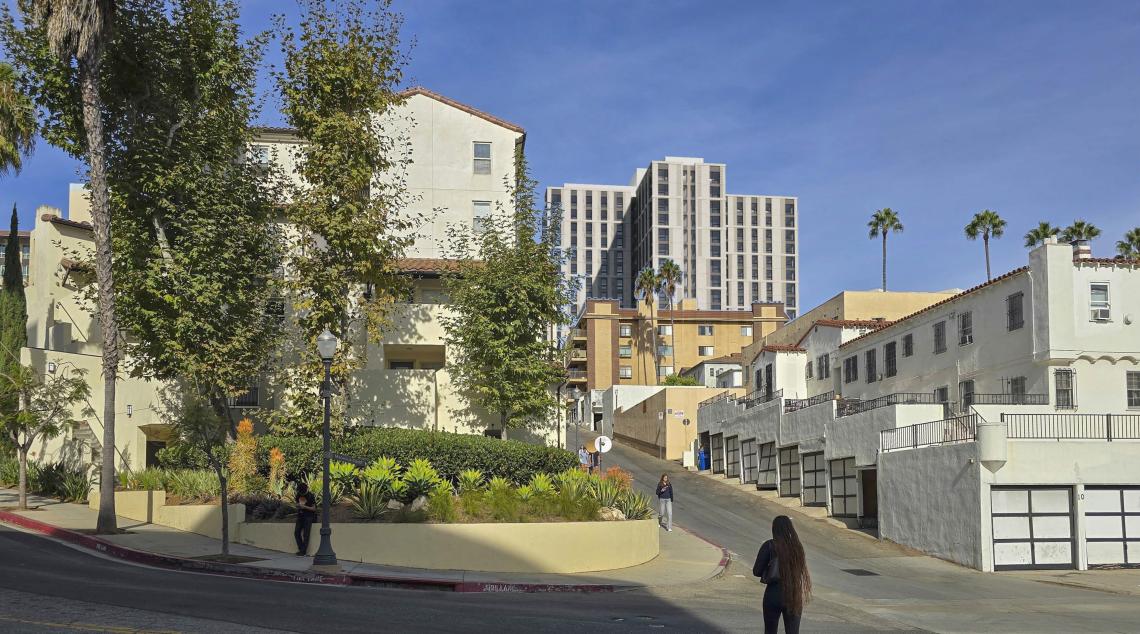A Tale of Two Markets, One Growing Pressure
When WalletHub named Irvine the hottest real estate market in California, few were surprised. The city has long been a model for planned growth, high-performing schools, and corporate stability. But beneath the good news lies a more complicated story — one that Los Angeles developers, investors, and land use consultants should pay close attention to.
Irvine’s surge tells us something critical about California’s urban dynamics in 2025: demand is not slowing — it’s shifting. The places once considered “safe bets” for moderate, predictable growth have become ground zero for a new kind of real estate tension. Buyers are competing fiercely and builders are racing to complete projects. While city permitting systems are straining under the weight of new demand.
This is the new normal — and Los Angeles is next in line.
The Irvine Effect: What’s Really Driving the Boom
WalletHub’s 2025 report ranked Irvine as the top large-city housing market in America. The city’s success comes from steady job growth, financial resilience, and a balanced housing supply. The numbers tell the story — low mortgage delinquencies, high credit scores, and a strong share of modern, well-planned housing.
But beyond the data lies a familiar pattern. Cities with clear zoning, consistent leadership, and reliable infrastructure always attract buyers escaping uncertainty elsewhere.
Los Angeles faces the opposite dynamic. Zoning gridlock, overlapping agencies, and murky regulations slow progress, even for well-funded projects. The result? Developers who can’t find predictability in LA often head to Irvine or the Inland Empire, where approvals move faster and returns come sooner.
That shift should worry Los Angeles officials — and energize developers who stay. Because for those who understand how to work within LA’s complex permitting system, the frustration hides enormous opportunity.

What Irvine Teaches About the Future of Permitting and Development
Irvine’s secret isn’t just demand — it’s design. Nearly one-third of its homes were built after 2010. That’s a staggering figure compared to Los Angeles, where much of the housing stock predates 1970.
New construction brings modern efficiencies — energy codes, seismic upgrades, sustainable design. But it also reflects a city government that knows how to approve and execute projects efficiently.
Compare that to Los Angeles, where many projects stall between entitlement and permit approval. Each step adds friction — environmental reviews, zoning variances, fire district checks, and design board reviews. What should take months can stretch into years.
At JDJ Consulting Group, we see the fallout every week. Developers come to us halfway through the process, already losing time and money. Often, it’s one small issue — a missing clearance or overlooked condition — that freezes their project in the City’s online portal.
The Irvine lesson is simple: process matters. Cities that streamline permitting attract capital. Cities that don’t lose it.
Los Angeles Isn’t Behind — It’s Just Bottlenecked
There’s a misconception that Los Angeles can’t compete with places like Irvine or San Diego. That’s not true. LA still has one of the most diverse economies and strongest real estate fundamentals in the nation.
What it lacks is regulatory predictability.
Between SB 9 infill developments, hillside restrictions, fire zone overlays, and evolving environmental compliance standards, Los Angeles projects are more complex by design. The good news is that with the right consulting support, those challenges are manageable — and often profitable.
Our firm works with clients to identify where a site’s potential is being artificially limited by process confusion. Often, a project that looks like it’s “stuck” can move forward once the entitlement pathway is clarified and properly documented. That’s where permit expediting and land use strategy converge.
In today’s LA market, speed is equity.
Buyers and Builders Are Playing a Different Game
In Irvine, buyers are fighting bidding wars. In Los Angeles, builders are fighting bureaucracy. Both are high-stakes competitions — and both demand precision.
For investors and developers, that means every property evaluation must now include three layers of due diligence:
-
Zoning and land use compatibility: Does the current zoning match the intended project? If not, can it be amended or varied?
-
Permit feasibility: How long will it actually take to move from entitlement to permit approval?
-
Infrastructure and jurisdiction: Which agencies control approvals? LADWP, Bureau of Engineering, or Fire Department — each has its own timeline and checklist.
Missing one layer can turn a profitable site into a stalled asset. That’s why investors who treat planning as seriously as financing are outperforming in 2025.
The Rise of Strategic Entitlement Planning
The Irvine boom also reinforces a major trend we’re seeing across Southern California: entitlement strategy is replacing speculation.
Gone are the days when investors could buy land, hold it, and wait for appreciation. Now, lenders, equity partners, and even municipalities want to see a defined pathway to development before capital is committed.
That’s where our consulting practice adds the most value. We don’t just expedite permits — we help our clients design projects that cities can say yes to.
That means:
-
Conducting early land use analyses before acquisition.
-
Aligning with local community plans and general plan updates.
-
Preparing environmental documentation that anticipates CEQA questions before they surface.
-
Coordinating with planning and building staff to clarify technical interpretations in advance.
When done correctly, this approach can shave months off a project timeline — and sometimes rescue a deal that’s about to collapse.
From Irvine to LA: The Investor’s Playbook for 2025
Developers who understand what’s happening in Irvine aren’t just watching — they’re adapting.
In Los Angeles, land remains expensive and entitlement rules are complex. That’s why smart investors are shifting toward redevelopment, adaptive reuse, and small-lot projects that fit within SB 9 and SB 10 guidelines.
That’s the sweet spot right now — projects that add density without triggering major zoning overhauls or CEQA delays.
The formula looks like this:
-
Find underutilized parcels within R2 or R3 zones.
-
Verify SB 9 eligibility (lot split, two-unit potential).
-
Evaluate parking and setback exceptions.
-
Secure early plan check review to anticipate code conflicts.
-
Submit complete, code-aligned documents to minimize resubmittals.
It’s a leaner, smarter way to build — and it’s how Los Angeles developers are staying competitive even as construction costs climb.
The Psychological Shift: Certainty Is the New Currency
One of the biggest takeaways from Irvine’s rise is psychological, not economic.
In a market where volatility feels constant — interest rates, labor costs, supply chain delays — certainty has become the most valuable commodity.
Buyers in Irvine are willing to pay premiums for predictability. Builders there enjoy smoother city processes. Investors prefer jurisdictions where approvals don’t linger in limbo.
In Los Angeles, achieving that same certainty requires expertise — not luck. You can’t rely on the City to move your project forward on schedule. You have to design your strategy to control what’s controllable.
That’s what we do at JDJ. We help our clients anticipate every potential obstacle so the approval path is defined before the first submittal is made. Because once a project enters the public system, your timeline belongs to the city. Our job is to make sure that timeline stays as short as possible.
The Larger Lesson: Efficiency Is Economic Development
Cities like Irvine have proven that a streamlined permit process isn’t just good governance — it’s economic strategy.
When builders can move from entitlement to groundbreaking, housing supply grows and investors reinvest locally. That creates a sustainable growth cycle.
Los Angeles, on the other hand, risks driving away opportunity when approvals drag on indefinitely. That’s why consulting, expediting, and entitlement planning are no longer optional services. They’re structural necessities for a functioning real estate ecosystem.
At JDJ Consulting Group, we advocate for this kind of systemic improvement. Our clients want to build responsibly and efficiently — and cities benefit when they do. The solution isn’t fewer rules. It’s clearer, faster, and more predictable ones.
Looking Ahead: What Comes After the Boom
Every cycle ends, and Irvine’s momentum will eventually normalize. But what happens next will depend on how cities across California respond to the current pressure.
If Los Angeles takes a page from Irvine’s playbook, it can win back momentum. The city needs to streamline permit pathways and improve coordination between departments.
These changes would help Los Angeles reclaim its place as California’s innovation hub for real estate development.
But if delays continue, investors will look elsewhere. Cities like Orange County and Riverside are already proving they can move faster and deliver results.
For developers who remain committed to LA, the solution is clear. Work with teams who understand the system, anticipate bottlenecks, and plan the permitting process from day one.
Final Thoughts
Irvine’s rise isn’t an isolated story — it’s a warning shot and an opportunity.
California’s housing future will be shaped not just by demand, but by how well cities handle complexity.
At JDJ Consulting Group, we believe Los Angeles can flourish if it rethinks the way it manages development. Of course, not by loosening standards, but by enforcing them intelligently.
Because when cities and builders work in sync, the result isn’t just more housing. It’s better housing, built faster, and aligned with community goals.
And in 2025, that’s what California needs most.






